
Zoom License Cost 2026: Which Plan Offers the Best Value for Your…
Table of Contents TogglePrioritize SaaS Renewals to Drive Cost Savings3 Questions...
Back
Back
Search for Keywords...
Blog

Table of Contents
In 2025, Zylo data shows that line of business owners are responsible for buying 51% of SaaS apps. That equates to 70% of total SaaS spend. In addition, the average organization experiences 247 renewals annually—or nearly 1 per business day. Without oversight into these applications, it’s difficult for IT and Finance to effectively manage software renewals.

Following SaaS renewal management best practices is the key to being proactive, driving efficiency, and making informed decisions that save money. In this guide, we’ll explain:
When your CFO or CIO comes to you with a $1M savings goal for the year, what do you do? To help you be the hero at your organization, we’ll give you the answer: focus on software renewals.
Why? The renewal is the only time you can make changes to your contract and reduce your spending.
The key is knowing when renewals are coming up over the next 12 months. With this approach, we’ve seen an average of 5-10% savings per application. That is your runway for cost savings and hitting—and even exceeding—your goal.
With the average company experiencing hundreds of renewals a year, there are many opportunities to save money.
As you prepare for each renewal, always answer these three questions.
By doing this, you’ll remove unnecessary applications, reduce license waste, and avoid overspending—funneling all the cost savings to your bottom line or critical business initiatives.
“Staying on top of a schedule and knowing what renews when is not an easy thing to do. [Renewing with] intelligence is to know what’s coming, what you’re using, and if what you’re paying is a reasonable price.”
— Keith Sarbaugh, CIO at Zoetis
To kick off the renewal conversation, determine if you need to renew the application. This evaluation should occur 120 days before your renewal date.
Ask yourself:
Our data shows that only half of licenses are used on average, though a healthy benchmark is 90% utilization. Understand what “good” usage looks like for the application and weigh that against actual usage.
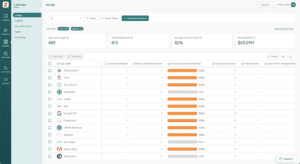
Redundancy is everywhere—especially in categories like online training classes, project management, and team collaboration.
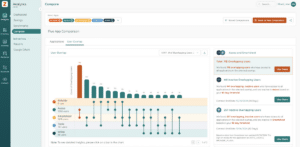
Lines of business leaders and their teams have intimate knowledge of the applications they use every day. Engage them at this stage in the renewal process to understand use cases and the value they’re getting from it.
If the application is rarely used and/or a similar tool already exists in your inventory, you may want to cancel the app. In your system of record, note that the app will be deprecated to ensure visibility of that decision to stakeholders. When the renewal date arrives, officially cancel the app in your system and tally your savings.
If you decide to keep an app, the next step is to understand whether you have the right user count. Determining the appropriate license quantity should occur 90 days ahead of renewal.
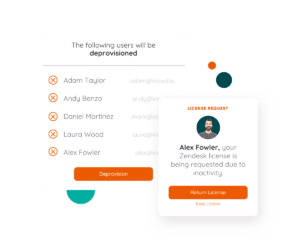 Follow these steps:
Follow these steps:
The risk here is twofold: not purchasing enough licenses or purchasing too many. On one side, you risk overage or true-up costs. On the other hand, you end up with waste—money you could have invested elsewhere.
Reclaiming licenses ahead of renewal gives you a more accurate view of the licenses you need. Automated workflows help you do this with ease.
Forecasting business needs and growth is critical to getting the right number of licenses.
Through 2027, Gartner predicts organizations will overspend on SaaS by at least 25%. To avoid overspending, start by understanding whether you’re paying a fair price with benchmark data—60 days ahead of renewal.
If you’re not, that becomes helpful leverage in negotiating down the price with your software vendors.
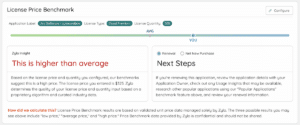
Need a place to get started with your SaaS renewals?
Following these SaaS renewal best practices helps operationalize your renewal process:
Assigning an owner to each application ensures you have a point of contact to work with on renewal preparation. When owners are not assigned, you risk making renewal decisions without stakeholder input.
To find an owner, start by looking at the business unit or the individual expense record. Track owners in a SaaS Management Platform (SMP) like Zylo and set alerts to audit and update them at least once a year.
According to the 2025 SaaS Management Index, the average organization spends $49M on SaaS annually. When you have visibility into all of your SaaS spend, it helps you:
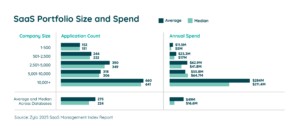
AI-powered SaaS discovery is the secret to uncovering all of your software spend—even those miscategorized and hidden in expense reports. Zylo’s SaaS Discovery connects to your finance and expense systems, providing insights such as:
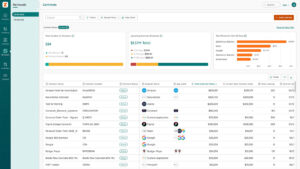
Getting all of your SaaS contracts into a system of record is essential for:
To begin, work with business owners to obtain final contract records. Similar to the first best practice, you can find contracts by going to the business unit or individual who purchased the app.
Another SaaS renewal best practice is to create a renewal calendar with all of your contract end dates. This helps you:
Take the manual work out of building a renewal calendar with an SMP. For example, in Zylo, once a contract is added, it will automatically plot the end date on the calendar.
Based on your renewal calendar, develop a quarterly, monthly, and weekly plan. At Zylo, we recommend taking a 120/90/60/30-day phased approach.
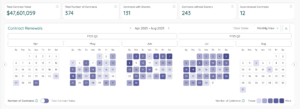
When you buy new software, it should be onboarded into your system of record. Establishing this intake process ensures:
To do this effectively:
The Ultimate Guide for Wildly Effective SaaS Renewals
Learn MoreWhen you follow these SaaS renewal best practices, IT and Finance can:
Think about a world in which you don’t have to waste time chasing the data. Instead, you can spend time optimizing your SaaS inventory and advise the business on how to implement innovative solutions and save money.
By preparing for renewals well in advance, you can:
As a procurement leader, following these best practices helps you become a strategic advisor to the business. It enables you to:
This helps you:
When you know your renewal dates and what you’re renewing, it creates a pathway to building your technology budgets. More importantly, forecasting future spending becomes easier due to having centralized historical data.
Asking the right questions and taking a proactive approach will ensure your renewals are managed effectively and drive business results. With nearly 10 years of experience leading SaaS Management, Zylo has a proven approach to operationalize renewals and help clients achieve meaningful cost savings. Take a look at our SaaS Renewal and Spend Management solution to learn more, or schedule time with our team.

Table of Contents TogglePrioritize SaaS Renewals to Drive Cost Savings3 Questions...

Table of Contents TogglePrioritize SaaS Renewals to Drive Cost Savings3 Questions...

Table of Contents ToggleKey Themes That Shaped SaaS Management in 20251....

Table of Contents TogglePrioritize SaaS Renewals to Drive Cost Savings3 Questions...
| Cookie | Duration | Description |
|---|---|---|
| cookielawinfo-checkbox-analytics | 11 months | This cookie is set by GDPR Cookie Consent plugin. The cookie is used to store the user consent for the cookies in the category "Analytics". |
| cookielawinfo-checkbox-functional | 11 months | The cookie is set by GDPR cookie consent to record the user consent for the cookies in the category "Functional". |
| cookielawinfo-checkbox-necessary | 11 months | This cookie is set by GDPR Cookie Consent plugin. The cookies is used to store the user consent for the cookies in the category "Necessary". |
| cookielawinfo-checkbox-others | 11 months | This cookie is set by GDPR Cookie Consent plugin. The cookie is used to store the user consent for the cookies in the category "Other. |
| cookielawinfo-checkbox-performance | 11 months | This cookie is set by GDPR Cookie Consent plugin. The cookie is used to store the user consent for the cookies in the category "Performance". |
| viewed_cookie_policy | 11 months | The cookie is set by the GDPR Cookie Consent plugin and is used to store whether or not user has consented to the use of cookies. It does not store any personal data. |
